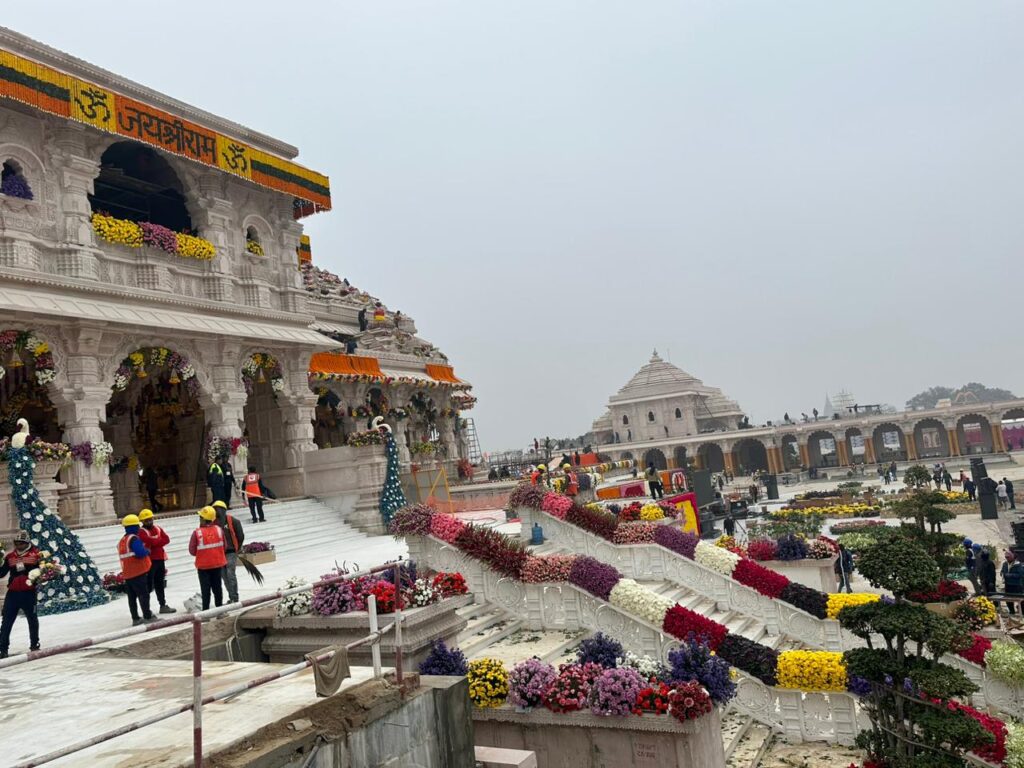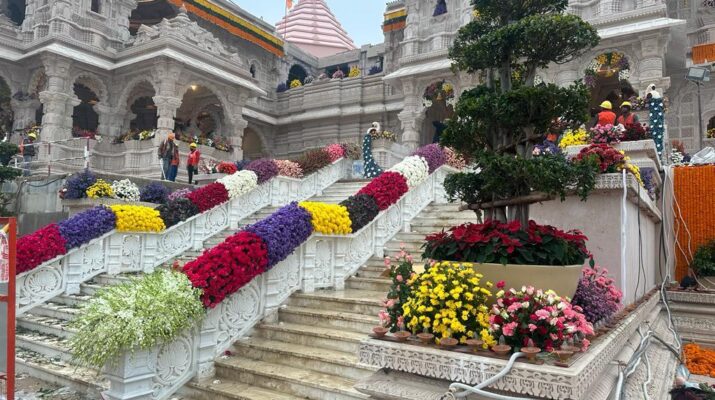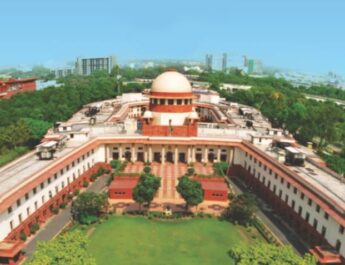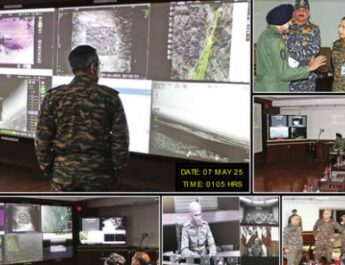Ayodhya Ram Mandir inauguration: Grand Opening Of Ayodhya Ram Temple
Ayodhya Ram Mandir inauguration: Not only are Ram, Krishna, and Shiv the three most commonly used names for the Almighty God in India. Even in these postmodern times, these are still some of the most popular names that parents give their sons. Ram and Krishna are frequently merged into one name. A baby boy named Sivaramakrishnan is sometimes given the name Sivaramakrishnan, especially in southern India. This greatly lessens the possibility of the Almighty being upset, assuming that he cares as much about proper etiquette as the majority of people do.
Today we invite you to go on the journey of Ramlala of Ayodhya, in which we will tell you the whole story from the history of the Mughal period to the construction of Ram temple. Apart from this, every feature of the Ram temple, how grand it is, how it was prepared, what is special… all the information will be given in this journey.
How did the consecration take place?
On January 18, the idol of Ramlala was installed in the sanctum sanctorum. Ramlala’s life was consecrated on January 22 at 12:20 pm. The blindfolds of Vigraha were removed and his picture was shown. The idol of Lord Rama is in the child form in the sanctum sanctorum of the temple.
121 Acharyas of 121 architects in the Pran Pratistha ceremony. During this, Prime Minister Narendra Modi, Mohan Mohan Bhagwat, UP Governor Anandiben Patel, CM Yogi Adityanath, and other Rafales were also present.
9 toilets and 2 pavilions have been prepared for the worship of Pran Pratistha. Eight cave pools were built in eight directions. Designed for an unloved restaurant. To make the home pond, sand, soil, cow dung, Panchgavya, and waste materials are used. Size, length, width, breadth, and depth have been taken care of.
In front of the main temple, two pavilions of 45-45 cubits have been built for worship. In one of the archives, the entire worship work was done starting from the worship of Lord Shri Ganesh and Shri Ram ji. In the second message, rituals related to the idol of Shri Ram ji were performed.
How is Ramlala looking?
The idol of 5-year-old child Ramlala installed in the sanctum sanctorum is amazing. It is made of dark-colored stone. The way Bal Ramla is described in Ramcharitmanas and Valmiki Ramayana is the same. The archer and arrows are not part of the statue.
The idol is very lifelike and pleasing to the heart. Even after seeing such a statue once, the eyes remained thirsty instead of satisfied. Eyes like lotus, face like moon, long hair, like a friendly friend.
The weight of the idol is approximately one tonne. 51 is the beginning. The special thing is that using stone to bathe the idol with water or milk should not have any effect on the water and milk. That means it would be appropriate to drink that water and milk, there would be no side effects on the human body.
In which style was the Ram Temple prepared?
The Ram temple was designed by the Sompura family of Gujarat and the entire plan of the temple is based on the traditional Nagar style. Nagar-style temples are constructed on a stone platform. There are stairs to go up. The largest in the sanctum sanctorum is always located at the bottom of the tower. There are simple peaks with square bases.
Some special temples built in Nagar style in India – Sun Temple of Konark, Sun Temple in Gujarat, Osian Temple, Kandariya Mahadev Temple of Khajuraho, Lingaraj Temple of Bhalu, Jagannath Temple of Puri.
How big is Ram temple?
While building the grand Ram temple in Ayodhya, every small and big thing has been taken care of. The work of the first phase has been completed. The temple was constructed in three storeys. The height of each floor is 20 feet. More than 4000 laborers were employed in the construction of the temple.
- Total land of temple complex 2.7 acres
- The area of temple construction is 57,400 square feet.
- Length of the temple (east to west) 360 feet
- width 235 feet
- The height of the peak of Garbha Graha from ground level is 161 feet.
- Temple floor 16.5 feet from ground level
- 392 pillars and 44 gates in the temple complex
- Statues of gods and goddesses on pillars and walls
- A total of 160 pillars on the ground floor
- 132 pillars on the first floor
- 74 pillars on the second floor
- A total of 12 gates in the temple complex
What is special in Ram temple?
Shriram Darbar on the first floor
Child form of Lord Shri Ram in the main sanctum sanctorum
20*20 feet octagonal-shaped sanctum sanctorum
Entry into the temple from the east (climbing 32 steps to Singhdwar)
the rectangular wall around the temple
The length of the rampart is 732 meters, width is 14 feet.
Four temples on the four ramparts – Suryadev, Maa Bhagwati, Ganapati, and Lord Shiva.
Temple of Maa Annapurna in the northern arm
Hanumanji’s temple in the southern arm
Jatayu statue on Navratna Kuber Tila in the south-western part
There are 5 pavilions in the temple – Dance Pavilion, Color Pavilion, Sabha Pavilion, Prayer Pavilion, and Kirtan Pavilion.
Facilities in Ram Mandir Complex
Ramp and lift for disabled and elderly
Own a power station in the temple premises
Sewer treatment plant, water treatment plant, water system for fire fighting
Lockers and medical facilities to keep the belongings of devotees
Bathroom, toilet, wash basin facilities
What things were used in the construction of the temple?
Iron was not used at all in the construction of the temple
Use of copper to join stones
14-meter thick RCC below the temple
no concrete above ground
21 feet high granite plinth to protect the temple from moisture
There is no danger even from a high-intensity earthquake
The building is expected to last for 1000 years
Things made of gold in the Ram temple
There are a total of 12 doors in the Ram temple complex from where devotees will enter. Here you will see doors shining with gold. Everything is covered with a thick layer of gold. These doors are made of teak wood which does not deteriorate for many years. These are decorated with elephant, conch, disc, and mace.
On the day of Pran Pratistha, Ram Lalla will be given a necklace made of 108 gold coins. Ram Lalla’s Charan Padukas will be made of silver and gold. His weight will be around 1 kg. Ramlala’s throne will be about 8 feet tall. From the crown to the jewelry will also be of gold. Apart from this, many people across the country have announced to gift gold and silver items to the Ram temple.
How many more temples are in the complex?
Apart from the main temple, 7 more temples are being built in the Janmabhoomi complex. These include the temples of Shri Ram’s Guru Brahmarshi Vashishtha, Brahmarshi Vishwamitra, Maharishi Valmiki, Agastya Muni, Ram devotee Kevat, Nishadraj and Mata Shabari, although their construction will be completed by the end of 2024.
which direction to reach the sanctum sanctorum
To have the darshan of Ramlala in the sanctum sanctorum, first of all, you have to go inside through the lion gate situated in the east direction. From here you will climb 32 stairs to reach Rang Mandap. In the Rang Mandap, pictures and characters related to the life of Lord Ram are carved on the walls. If you walk a little further, you will come to the dance pavilion.
In the dance pavilion, deities and scenes from Ramayana are carved on stones. Moving ahead from here, you will reach the sanctum sanctorum of Ramlala.
Where did everything come from for Pran Pratishtha and Ram temple?
Lucknow’s vegetable seller Anil Kumar Sahu has dedicated a world clock to Ramlala by making it which tells the time of 9 countries simultaneously.
More than three thousand gifts, jewelry, and clothes came to Ayodhya from Janakpur (Nepal), the birthplace of Mother Sita.
A Sri Lankan delegation presented a rock from Ashoka Vatika mentioned in the epic Ramayana
108-foot-long incense stick arrived in Vadodara, Gujarat, which weighs 3610 kg and is about 3.5 feet wide.
Challa Srinivas Shastri, an unwavering devotee of Lord Ram from Hyderabad, reached Ayodhya on foot to present the gold-plated Khadaun.
Farmer Arvindbhai Mangalbhai Patel, resident of Vadodara, has presented a huge lamp weighing 1100 kg made of Panchdhatu.
Aligarh’s locksmith Satya Prakash Sharma has prepared a lock and key weighing 400 kg, it is being said to be the world’s largest lock and key.
Nagpur’s chef Vishnu Manohar will prepare 7000 kg of traditional sweet ‘Ram Halwa’ for the devotees attending Pran Pratistha.
Shri Krishna Janmasthan Seva Sansthan in Mathura sent 200 kg laddus to Ayodhya for ‘Yagya’.
The official trust of Sri Venkateswara Temple in Tirupati will send one lakh laddus to Ayodhya for Ram devotees.
What is the role of Shri Ram Janmabhoomi Teerth Kshetra Trust?
Prime Minister Narendra Modi announced the name of the trust for the Ram temple in the Lok Sabha on 5 February 2020, which was named ‘Shri Ramjanmabhoomi Teerth Kshetra’. There are a total of 15 members in this trust. It is the responsibility of this trust to look after the construction and administrative work of the temple. Among the members of the Trust, names like Padmashree Advocate K Parasaran, Kameshwar Chaupal, Swami Vasudevanand Saraswati, Swami Vishvaprashatratirtha, Yugpurush Parmanand Giri, Mahant Dinendra Das are prominent.
Taking care of the facilities and security of the devotees, controlling the crowd, managing the budget, organizing pujas, rituals, and religious events are all the work of the Trust. There will be no government interference in all these works.
How much money has the trust received in donations so far?
Ram Mandir Trust has received donations worth crores of rupees from India and abroad. Initially, the target of the trust was to collect donations of Rs 900 crore from 11 crore people. But, according to media reports, donations worth more than Rs 5000 crore have been received so far.
Shri Ram Janmabhoomi Teerth Kshetra had told in March 2023 that Rs 3000 crore had arrived in its three bank accounts. It is being told that many devotees have even donated gold coins and biscuits. According to the report, the estimated cost of building Ram temple is around Rs 1800 crore.
Temple timings and ticket cost
The timing of darshan in Ram temple every day will be from 7 am to 11:30 am and from 2 pm to 7 pm. Timings may change on some special occasions and festivals. The time of Shringaar Aarti is 6:30 am. Bhog Aarti will be held at noon and Sandhya Aarti will be held at 7:30 pm.
Darshan in Ayodhya Ram temple is free for all the devotees. But if you want to have a closer and better darshan of Lord Ram, then you will have to buy a special darshan ticket. Devotees can book tickets online from the official website of Shri Ram Janmabhoomi Teerth Kshetra Trust (SRJTKT), srjbtkshetra.org.
How to reach Ayodhya Ram Nagri
All types of means are available to go to Ayodhya Ramnagari. Devotees can go anytime according to their devotion by bus, rail, or air. Many buses of Uttar Pradesh State Road Transport Corporation (USRTC) run between Ayodhya and neighboring cities like Lucknow, Faizabad, and Gorakhpur.
If you want to go by train, then there is a railway station named ‘Ayodhya Dham Junction’ in Ayodhya itself. Direct trains go to Ayodhya from Delhi, Lucknow, Kanpur, Banaras, and Gorakhpur. If you want to save time, there is also an international airport in Ayodhya. One direct flight each from Delhi and Mumbai to Ayodhya has been started. Apart from this, Gorakhpur (118 km) and Lucknow Airport (125 km) are the nearest ones. From here one can easily reach Ayodhya by taxi, bus or train.
When will the construction of the three-storey Grand Ram Temple be completed?
The three-storey grand Ram Temple in Ayodhya will be ready by December 2024. The construction of the ground floor in the first phase has just been completed. The work on the first and second floors will be completed by the end of this year.
Temple Construction Committee Chairman Nripendra Mishra said in a statement that the Ram temple is expected to last for at least 1000 years. According to the report, 1.5 lakh devotees are expected to come daily by the end of the year.
How much has Ayodhya changed since before?
There is development everywhere in Ayodhya. The UP government has kept a budget of Rs 30 thousand crore to make Ayodhya a world-class city. The UP government aims to transform Ayodhya into the cultural capital of India. Most of the proposed projects will be completed in 2024.
The list of development works in Ramnagari is very long. Of these, Ayodhya Dham railway station and international airport have been inaugurated. The biggest gift is going to be received in the form of Solar City by March this year. Apart from this, work has been done on some of these projects.
- 4 Lane Ayodhya Akbarpur Baskhari Marg
- Railway level crossing from NH-27 to Rampath
- over bridge at railway crossing
- Development of tourist places and ponds
- widening of roads
- heritage light on the road
- Green Field Township Project
- Construction of permanent ghats at Rajghat
- Renovation of old ghats
- Audience gallery at Ram ki Pauri
- Beautification of pilgrim path
What is the price of land in Ayodhya?
The price of land in Ayodhya has increased 10 times. Recently Bollywood superstar Amitabh Bachchan has bought a plot worth Rs 14.5 crore in Ayodhya. This plot has been purchased in 7 Star Enclave The Saryu. The UP government has fixed the price of residential land at Rs 37,870 per square. At the same time, the price of land of monastery, temple, and charitable trust has been fixed at one and a half times more.
The government has issued some guidelines for land buyers in Ayodhya. If anyone has land around Ram Temple, the government can take it anytime if needed under Section 1993. Also, while doing business near the temple campus, special care should be taken that the faith of the common people should not be hurt.
History of Ram Temple
With the inauguration of Ram temple, the 500 years of wait of Ram devotees ended. According to Ramayana, Lord Shri Ram was born in Ayodhya only. It is said that Lord Shri Ram’s son Kush had built his temple in Ayodhya. There were 3000 temples of Sitaram in Ayodhya alone. Historians say, in the 5th century the condition of many of these temples started deteriorating. During the same time, King Vikramaditya of Ujjain came to Ayodhya and got the temples repaired. Then the temple remained fine for many years.
On 21 April 1526, there was a war between Babar and Ibrahim Lodhi. By 1528, Babar’s army reaches Ayodhya. It is claimed that the mosque was constructed after the temple was demolished on the orders of Mughal emperor Babar. Later it came to be known as Babri Masjid.
At that time Babar was ruling and its roots were very strong. That’s why 250 years have passed and there has been no movement here. European geographer Joseph Tiefenthaler was at this place between 1766 and 1771. In his book Descriptio India, he talks about the existence of Ram Chabutra here.
For the first time in 1813, Hindu organizations claimed that Babar had demolished the Ram temple and built a mosque. From here this issue started arising again. At that time the country was ruled by the British. Communal violence occurred here for the first time in 1853. Seeing the increasing dispute, in 1859 the British installed a fence around the disputed site.
The case reached the court for the first time in 1885. Mahant Raghubir Das filed a petition in the Faizabad district court to build a temple on Ram Chabutra, which was rejected by the court. In 1949, an idol of God was found inside the mosque. While the Hindu side claimed the appearance of Lord Ram, the Muslim side said that the Hindus secretly placed the idols inside. Both sides filed cases against each other. On the other hand, the administration considered it a disputed structure and got it locked.
In 1950, Gopal Singh Visharad filed a petition seeking permission to worship at Ram Chabutra. In 1959, Nirmohi Akhara filed the third application for possession. In 1961, the UP Sunni Waqf Board filed a petition and laid claim to the mosque land. In 1986, the district court allowed opening of the disputed structure and permission for darshan. In 1989, Vishwa Hindu Parishad laid the foundation stone of Ram temple on the disputed land and laid the first stone.

The disputed structure of Babri Masjid was demolished
Vishwa Hindu Parishad had already started the movement to build a Ram temple instead of a mosque on the disputed land. In the 90s, the issue of Ram Temple was of paramount importance for politicians. In 1990, Lal Krishna Advani took out a Rath Yatra for the construction of the temple. This anger had increased so much that in 1992, all the Hindu organizations including VHP together demolished the disputed structure.
After this, communal riots broke out across the country. More than 2000 people died in the riots. A case was registered and 49 people were accused. Many BJP and VHP leaders including Lal Krishna Advani, Uma Bharti, Murli Manohar Joshi, Kalyan Singh, Champat Rai, and Kamlesh Tripathi were accused. After 28 years, the court acquitted all the accused due to lack of evidence. 17 accused had died at the time of the verdict.
When the decision came in favor of Ram temple
In 2002, 10 years after the demolition of the disputed structure, the Allahabad High Court started hearing for ownership rights on the land. In 2010, the High Court ordered to division the disputed land into three equal parts between the Sunni Waqf Board, Ram Lalla Virajman, and Nirmohi Akhara. In 2011, the High Court order was challenged in the Supreme Court.
In 2019, a five-judge bench of the Supreme Court ruled in favor of the Ram temple. Orders were given to give five acres of land separately to Muslims. After this, on 5 August 2020, Prime Minister Modi performed Bhoomi Pujan for the construction of Ram temple and now the temple has been inaugurated on 22 January 2024.




